LED displays have revolutionized the way we convey information, both in indoor and outdoor settings. Two common types of LED technologies dominate the market: SMD (Surface-Mounted Device) LED and DIP (Dual In-line Package) LED. Each has unique characteristics, and knowing their differences is crucial for making the right choice depending on your application. Let’s break down these two types of LED displays and explore how they differ in terms of structure, performance, and usage.

1. LED Structure
The fundamental distinction between SMD and DIP LEDs lies in their physical structure:
SMD LED Display: In an SMD display, the LED chips are mounted directly onto the surface of a printed circuit board (PCB). A single SMD LED typically contains red, green, and blue diodes in one package, forming a pixel.
DIP LED Display: DIP LEDs consist of separate red, green, and blue diodes encased in a hard resin shell. These LEDs are mounted through holes in the PCB, and each diode forms part of a larger pixel.
2. Pixel Design and Density
The arrangement of LEDs impacts the pixel density and image clarity of both types:
SMD: Because all three diodes (RGB) are contained in one small package, SMD LEDs allow for greater pixel density. This makes them ideal for high-resolution displays where fine details and sharp images are required.
DIP: Each color diode is placed separately, which limits the pixel density, especially in smaller pitch displays. As a result, DIP LEDs are typically used in applications where high resolution is not a top priority, such as large outdoor screens.
3. Brightness
Brightness is another critical factor when choosing between SMD and DIP LED displays:
SMD: SMD LEDs offer moderate brightness, typically suitable for indoor or semi-outdoor environments. Their primary advantage is superior color blending and image quality, rather than extreme brightness.
DIP: DIP LEDs are known for their intense brightness, making them ideal for outdoor applications. They can maintain clear visibility in direct sunlight, which is one of their most significant advantages over SMD technology.
4. Viewing Angle
Viewing angle refers to how far off-center you can view the display without losing image quality:
SMD: SMD LEDs offer a wider viewing angle, often up to 160 degrees horizontally and vertically. This makes them a popular choice for indoor displays, where audiences view screens from multiple angles.
DIP: DIP LEDs tend to have a narrower viewing angle, typically around 100 to 110 degrees. While this is adequate for outdoor settings where viewers are typically far away, it is less ideal for up-close or off-angle viewing.
5. Durability and Weather Resistance
Durability is essential, especially for outdoor displays that face challenging weather conditions:
SMD: While SMD LEDs are suitable for many outdoor uses, they are less robust than DIP LEDs in extreme weather conditions. Their surface-mounted design makes them slightly more vulnerable to damage from moisture, heat, or impacts.
DIP: DIP LEDs are generally more durable and offer better weather resistance. Their protective resin casing helps them withstand rain, dust, and high temperatures, making them the go-to choice for large outdoor installations like billboards.
6. Energy Efficiency
Energy consumption can be a concern for long-term or large-scale installations:
SMD: SMD displays are more energy-efficient than DIP displays due to their advanced design and compact size. They require less power to produce vibrant colors and detailed images, making them a good choice for energy-conscious projects.
DIP: DIP displays consume more power to achieve their high brightness levels. This increased power demand can lead to higher operational costs, especially for outdoor installations that run continuously.
7. Cost
Budget plays a significant role in deciding between SMD and DIP LED displays:
SMD: Typically, SMD displays are more expensive due to their high-resolution capabilities and more complex manufacturing process. However, their performance in terms of color accuracy and pixel density justifies the cost for many applications.
DIP: DIP displays are generally more affordable, especially for larger, lower-resolution outdoor installations. The lower cost makes them a popular choice for projects that require durability but not necessarily fine detail.
8. Common Applications
The type of LED display you choose will depend largely on the intended application:
SMD: SMD LEDs are widely used for indoor displays, including conference rooms, retail signage, trade show exhibits, and television studios. They are also found in smaller outdoor installations where high resolution is essential, such as close-up advertising screens.
DIP: DIP LEDs dominate large outdoor installations, such as billboards, stadium screens, and outdoor event displays. Their robust design and high brightness make them perfect for environments where extreme durability and sunlight visibility are required.
Conclusion: Choosing Between SMD and DIP LED Displays
When selecting between an SMD and DIP LED display, it’s important to consider the specific requirements of your project. If you need high resolution, wide viewing angles, and better image quality, especially for indoor settings, SMD LED displays are the way to go. On the other hand, for large-scale outdoor installations where brightness, durability, and cost-effectiveness are crucial, DIP LED displays are often the better choice.
Post time: Oct-23-2024



